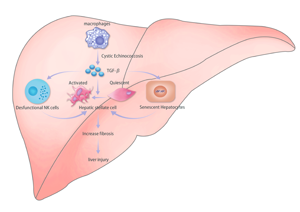Article contents
A combination of pirfenidone and TGF-β inhibition mitigates cystic echinococcosis-associated hepatic injury
Published online by Cambridge University Press: 15 February 2021
Abstract

Cystic echinococcosis (CE) occurs in the intermediate host's liver, assuming a bladder-like structure surrounded by the host-derived collagen capsule mainly derived from activated hepatic stellate cells (HSCs). However, the effect of CE on liver natural killer (NK) cells and the potential of transforming growth factor-β (TGF-β) signalling inhibition on alleviating CE-related liver damage remain to be explored. Here, by using the CE-mouse model, we revealed that the inhibitory receptors on the surface of liver NK cells were up-regulated, whereas the activating receptors were down-regulated over time. TGF-β1 secretion was elevated in liver tissues and mainly derived from macrophages. A combination of TGF-β signalling inhibitors SB525334 and pirfenidone could reduce the expression of TGF-β1 signalling pathway-related proteins and collagen production. Based on the secretion of TGF-β1, only the pirfenidone group showed a depressing effect. Also, the combination of SB525334 and pirfenidone exhibited a higher potential in effectively alleviating the senescence of the hepatocytes and restoring liver function. Together, TGF-β1 may be a potential target for the treatment of CE-associated liver fibrosis.
Keywords
- Type
- Research Article
- Information
- Copyright
- Copyright © The Author(s), 2021. Published by Cambridge University Press
Footnotes
These authors contributed equally to this work.
References
- 5
- Cited by



